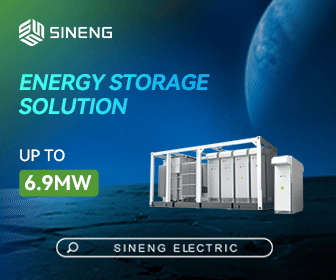Siemens, DEPCOM Power and Local Utility Come Together to Provide Affordable, Efficient Renewable Power
DEPCOM Power was hired by a local utility to design, build and maintain a Battery Energy Storage System (BESS) that delivers 800 megawatt hours of stored solar and wind power to some 42,000 customers. This 10-acre project consists of highly modified 20-foot ISO containers with Lithium Iron Phosphate (LFP) batteries which are connected to centralized inverters, and are then interconnected to a transmission substation. The batteries require a substantial amount of auxiliary power, primarily for temperature control, so an expansive 480V 3P AC network is utilized to distribute power to each of the 360 battery containers. The auxiliary protection components consist of a network of switchboards and panelboards which all contain Siemens 3WA and 3VA line circuit breakers. The batteries must run at an optimal temperature range, requiring an HVAC system to keep them from overheating.
The HVAC system has to operate continuously. If power from the grid goes out, an auxiliary switchboard engages a generator for backup power. DEPCOM Power contracted North Carolina-based electrical switchboard provider EPEC and its agent, ReBoSS, to deliver a highly customized auxiliary power switchboard system to control the HVAC and monitor the current flowing to the batteries. This auxiliary power system is made up of a network of switchboards and panelboards that are each equipped with a fleet of Siemens 3VA6 molded case circuit breakers and two Siemens 3WA main air breakers, both of which are assembled at the Siemens Mayfield plant in Grand Prairie, TX.
Adding Grid Stability Expected to reach completion in summer 2025, the project is a 200-megawatt standalone energy storage project delivering over 800 megawatt hours of energy. Its primary purpose is to provide grid stability by storing excess solar power and distributing it after sundown to nearby homes when they need it most. The project delivers enough electricity to keep about 42,000 homes powered for four hours after sundown.
Solar energy is harnessed during the morning and early afternoon, when the sun is strongest. “Excess solar that is produced during the daytime is utilized to charge these batteries,” said Mark Sauls, Vice President of Sales and Operations for EPEC Solutions. “And then after the sun goes down, the batteries discharge and you have an extra four hours of power.”
This BESS project fits into the local utilities aggressive sustainability strategy. The utility is striving for net zero direct greenhouse gas emissions by 2050. The project is one of the largest battery storage systems in the American Southwest, using its storge capability to add stability and reliability to energy sources that are inherently intermittent.
“This site is actually located relatively close to a population center, so it's available – and not transmission constrained – to deliver power to the city,” said Walker Wentzler, Sr. Director of Electrical Engineering at DEPCOM Power. “It is really making up for those peaks and valleys when people get home and turn on all their appliances.”
Maintaining a Steady Operation Energy arrives at the project’s BESS through the local power distribution network. It is then stored in the lithium iron phosphate batteries. These batteries leverage newer technology that delivers longer life and make them safer to operate. “The batteries need to stay cool or within a relatively finite temperature band for them to operate for their entire life and continue performing,” said Wentzler.
The liquid heating and cooling system controls the temperature of the circulating fluid within the battery modules to keep the battery cells in ideal temperature range – and should the utility power go out, the cooling system must continue operating. That’s where the EPEC switchboard comes in, providing power to the HVAC and maintaining the batteries in a steady state.
DEPCOM Power turned to EPEC for the auxiliary power switchboard for a number of reasons. The system is highly flexible and customizable and delivers the functionality the facility needed while keeping people safe by reducing arc flash, said Wentzler.
The switchboards were assembled by EPEC’s manufacturing arm, QT Corp., and delivered by ReBoSS. They are double-ended, low-voltage units with two electrically switchable Siemens 3WA main breakers and 14 3VA6 circuit breakers in each switchboard.
“The dual 3WA main breakers have a purpose,” said Drew Vermillion, president of ReBoSS. “We have a backup breaker in case the substation goes down. The second main breaker is then powered by a secondary utility feed to keep the HVAC running on the battery storage system. The main breakers feed the 3VA6 molded case circuit breakers that feed out to auxiliary distribution panels and the HVAC systems.”
The Siemens Advantage “EPEC has equipped its switchboards with Siemens circuit breakers for years. Units like the 3VA6 offer a host of features ideal for grid stability projects, starting with build quality," Sauls said. “The reliability, efficiency, and communication capabilities of the 3VA6 molded case circuit breaker far exceeds other big-name competitors.”
For this project, EPEC used its innovative solar-specific UL 891 dead front switchboard, which minimizes cable sizes, reducing implementations by 40%. Thanks to the reduction in cabling, the switchboard is more cost-effective and quicker to install.
This project is another example of how Siemens technologies are enabling its customers to be energy diverse, efficient and resilient.
The Siemens 3VA6 molded case circuit breakers deliver a host of benefits:
Electronic Tripping
3VA6 breakers are equipped with electronic tripping, which is preferable to thermal magnetic circuit breakers in BESS applications. BESS projects often operate in harsh environments. In Arizona, temperatures can rise well above 100 degrees Fahrenheit for extended periods. Because thermal magnetic circuit breakers are very susceptible to ambient temperatures, nuisance tripping can become an issue. But that does not occur with electronic tripping.
Built-in Metering
-
DEPCOM Power needed a switchboard with metering capabilities in order to monitor the feeder circuit breakers and measure the auxiliary power consumption of the batteries. 3VA6 circuit breakers have built-in metering capability, making it possible to remotely monitor the current. “Each 3VA6 breaker actually monitors the current and lets the owner know how much current is flowing out to the panel board, which then flows to the HVAC of the battery containers. By monitoring the current of that 3VA6, they're actually able to determine the health of the HVAC system and therefore the health of the overall plant,” Sauls said.
Monitoring capabilities were especially important, Wentzler said. “This asset is going to be largely unmanned and operated from a remote standpoint, and so one of the options that we leveraged with the 3VA line was basically a bolt-on addition to those breakers.” This enables remote operators to track consumption at a very granular level and take action when troubleshooting is necessary, he said.
• Flexibility and Safety The 3VA6 molded case circuit breakers delivered the flexibility and safety required for this BESS project. “They have all the latest features like the arc energy reduction maintenance switch, and then they have the built-in safety codes that OSHA (Occupational Safety and Health Administration) and the NEC (National Electric Code) require,” Vermillion noted.
To keep people safe, it was crucial to have molded case circuit breakers with a high short circuit breaking capacity, according to Wentzler. The breakers allow technicians to adjust parameters as needed and reduce arc flash “There's a pretty high peak load for auxiliary consumption for the HVAC and chillers to keep the systems cool, so what you wind up with on a system of this size is a very expansive low-voltage, 480-volt auxiliary distribution network. The 3VA line offers a lot of flexibility in being able to get to some very, very high levels of breaking current.”
Customization
The project required several customizations, which included designing a larger auxiliary panel board that handles larger cables and includes an external, lockable rotary operator for technicians to turn it on and off without opening the panel door.
In addition, the two Siemens 3WA main breakers allowed for customization that DEPCOM Power needed to automate and interlock the systems. “Being able to close and then interlock between the two main breakers with the Siemens continuous shunt trip was really key in being able to put together an economical solution that is also effective in long term operations,” said Wentzler.
The Value of Partnership
The Siemens 3VA and 3WA lines are critical components in the BESS project, delivering the functionality, flexibility and safety needed in a harsh environment. “I think the 3WA main and 3VA6 breakers have just been rock stars for us in the renewable space, which is very demanding on a breaker,” said Vermillion.
“Siemens can always be counted on for reliability, quality, and support,” said Sauls. Siemens understood the importance of shipping on time and the need for communication with EPEC along the way to ensure a smooth process. “What we’re looking for in a partner is someone that's interested in our business and is willing to go the extra mile for us. Siemens has done that from the beginning,” he said.
Building a Diverse Energy Mix
The local utility is addressing an important need in an area of the country where solar power is abundant. It serves as a cost-effective, energy-efficient and innovative example of how to address the country’s energy supply challenges.
“We don't have enough energy in this country,” said Vermillion. “We need natural gas, we need nuclear, and we need solar – and using large-scale battery sites is the next step. Having a diverse energy generation a beautiful thing, and this brings a lot of great value to Arizonans.”
Siemens | https://www.siemens.com/global/en.html
DEPCOM Power | https://www.depcompower.com/









